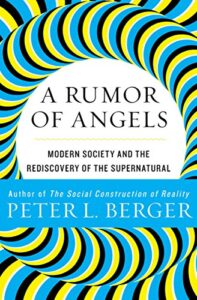The BEST: A Rumor of Angels

 In his slim 1969 work, A Rumor of Angels: Modern Society and the Rediscovery of the Supernatural, sociologist of religion Peter L. Berger offers a glimpse into his personal approach to faith and theology. Born to a Viennese Jewish family which converted to Christianity when he was a child, Berger was a prominent sociologist whose early books explored religion in light of secularization. In A Rumor of Angels Berger explores the ways secular modern western society is increasingly skeptical regarding the supernatural, resulting not only in the demise of religious commitment but also how it poses a challenge to the remaining faithful few who are now a cognitive minority. Since human belief systems are usually reinforced by social structures, Berger argues that secular societies impose immense pressures on religious individuals, and in response offers an insight often quoted by faith leaders: that the person seeking to maintain their faith in a secular society “must huddle together with like-minded fellow deviants—and huddle very closely indeed.” Only by creating communities of fellow believers, what he calls social plausibility structures, can individuals strengthen their ability to believe in God.
In his slim 1969 work, A Rumor of Angels: Modern Society and the Rediscovery of the Supernatural, sociologist of religion Peter L. Berger offers a glimpse into his personal approach to faith and theology. Born to a Viennese Jewish family which converted to Christianity when he was a child, Berger was a prominent sociologist whose early books explored religion in light of secularization. In A Rumor of Angels Berger explores the ways secular modern western society is increasingly skeptical regarding the supernatural, resulting not only in the demise of religious commitment but also how it poses a challenge to the remaining faithful few who are now a cognitive minority. Since human belief systems are usually reinforced by social structures, Berger argues that secular societies impose immense pressures on religious individuals, and in response offers an insight often quoted by faith leaders: that the person seeking to maintain their faith in a secular society “must huddle together with like-minded fellow deviants—and huddle very closely indeed.” Only by creating communities of fellow believers, what he calls social plausibility structures, can individuals strengthen their ability to believe in God.
In his analysis, Berger also provides tools for believers to push back against intellectual secular pressures. One approach is that of “relativizing the relativizers.” Secular thinkers, according to Berger, approach faith with a double standard in which they use sociological knowledge to relativize and deconstruct past religious traditions but do not subject their own beliefs to the same scrutiny. One tool in the arsenal of believers is to engage in the same exercise of relativization applied to modern critiques of religion.
Beyond taking on critics of religious belief, Berger also describes his own approach. His is not the traditional embrace of the explicitly supernatural but resembles instead the modern enterprise of seeking God by rational means. He offers an inductive orientation that looks at the world and finds traces of transcendence (hence the book’s title). Unlike Maimonides, who sought God’s imprint in the laws of the natural universe, Berger follows his sociological impulses and seeks transcendence in human behavior. He describes five major human signals of transcendence: the human belief that the world is ordered, the ability to play, the capacity to hope, the belief that some things are worthy of condemnation, and the capacity to laugh. Berger argues these aspects of human experience cannot be rationally explained and point instead to “signals of transcendence.”
Why this is The BEST? Berger’s A Rumor of Angels has several key implications for Jews in the modern world. First, Berger provides sociological language to explain the dangers of being a cognitive minority in an open society. His advice to “huddle together” with fellow believers is essentially the sociological model that’s been adopted by Orthodox Jews and other traditional communities that realized this was the most potent way to ensure group continuity in America. It is less a theological justification for “am le-vadad yishkon” (“A people which dwells apart”; Numbers 23:9) and more a sociological explanation for the necessity of building independent and socially insulated communities that can allow religious individuals to overcome the assimilatory pressures of secular society.
In this work Berger also models a different path of how to be a believer immersed in secular society—a somewhat lonely but still confident intellectual that insists on the possibility of transcendence. Tellingly, Berger is not huddled together with fellow believers; rather, his colleagues are academics and secular students. This route is hard and might not be the best for communal retention of religious commitment, but it does offer a way academics can retain their religious beliefs while immersing themselves in a secular, intellectual world.
Dr. Mijal Bitton is Scholar in Residence at the Shalom Hartman Institute and the Rosh Kehilla of the Downtown Minyan.
Click here to read about “The BEST” and to see the index of all columns in this series.
